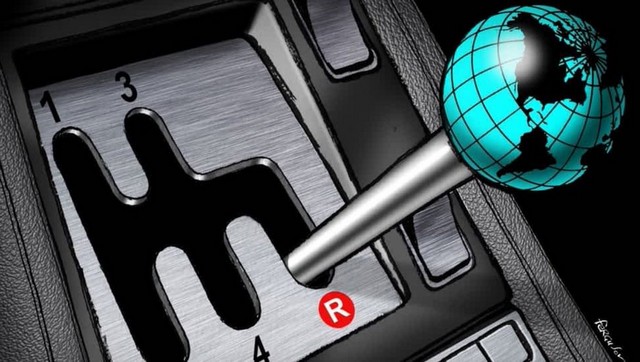By Martin Wolf
Trade liberalisation has stalled and one can see a steady rise in protectionist measures
Has the tide of globalisation turned? This is a vitally important question. The answer is closely connected to the state of the world economy and the west’s politics.
Migration raises quite specific issues. The era of globalisation was not accompanied by a general commitment to liberalising flows of people. So I will focus here on trade and capital flows. The evidence in these areas seems quite clear. Globalisation has reached a plateau and, in some areas, is in reverse.
An analysis from the Peterson Institute for International Economics argues that ratios of world trade to output have been flat since 2008, making this the longest period of such stagnation since the second world war. According to Global Trade Alert, even the volume of world trade stagnated between January 2015 and March 2016, though the world economy continued to grow. The stock of cross-border financial assets peaked at 57 per cent of global output in 2007, falling to 36 per cent by 2015. Finally, inflows of foreign direct investment have remained well below the 3.3 per cent of world output attained in 2007, though the stock continues to rise, albeit slowly, relative to output.
Thus, the impetus towards further economic integration has stalled and in some respects gone into reverse. Globalisation is no longer driving world growth. If this process is indeed coming to an end, or even going into reverse, it would not be the first time since the industrial revolution, in the early 19th century. Another period of globalisation, in an era of empires, occurred in the late 19th century. The first world war ended this and the Great Depression destroyed it. A principal focus of US economic and foreign policy after 1945 was to recreate the global economy, but this time among sovereign states and guided by international economic institutions. If Donald Trump, who has embraced protectionism and denigrated global institutions, were to be elected president in November, it would be a repudiation of a central thrust of postwar US policy.
Given the historical record and the current politics of trade, notably in the US, it is natural to ask whether the same could happen to the more recent era of globalisation. That requires us to understand the drivers.
Part of the reason for the slowdown is that many opportunities are, if not exhausted, radically diminished. When, for example, the production of essentially all labour-intensive manufactures has moved out of the rich countries, the growth of trade in such products must fall. Similarly, when the biggest investment boom in the history of the world, that in China, slows, so too must the demand for many commodities. That will affect both their prices and their quantities. Again, the end of once-in-a-lifetime global credit boom is sure to lead to a decline in the cross-border holdings of financial assets. Finally, after decades of FDI, a host of companies with something to gain from it will have taken their opportunity and succeeded or, in important cases, failed.
Yet this is not all there is to this story. Trade liberalisation has stalled and one can see a steady rise in protectionist measures. The financial crisis brought with it regulatory measures, many of which are bound to slow cross-border financial flows. The rise of xenophobic sentiment and the slowdown in trade are both likely to reduce the growth of FDI. In brief, policy is less supportive.
The politics are becoming even less so. Again, the US is the central part of the story. Mr Trump is much the most protectionist candidate for US president since the 1930s. But, revealingly, Hillary Clinton, an architect of the US “pivot to Asia” has turned against the Trans-Pacific Partnership of which she was once a keen supporter. The Transatlantic Trade and Investment Partnership, being negotiated between the US and the EU, is now in deep trouble. The Doha round of multilateral trade negotiations is moribund. Above all, important segments of the western public no longer believe increased trade benefits them. Evidence on relative real incomes and adjustment to rising imports provides some support for such scepticism.
Globalisation has at best stalled. Could it even go into reverse? Yes. It requires peace among the great powers. Some would also argue it requires a hegemonic power: the UK before 1914 and the US after 1945. At a time of poor economic performance in leading high-income countries, rising inequality and big shifts in the balance of global power, another collapse must be a possibility. Consider the impact of any fighting between the US and China over the South China Sea, though such a calamity would be terrifying for far more than its narrow economic effects.
Does globalisation’s stalling matter? Yes. The era of globalisation has seen the first fall in global inequality of household incomes since the early 19th century. Between 1980 and 2015, average global real income rose by 120 per cent. The opportunities afforded by globalisation are vital. Our future cannot lie in closing ourselves off from one another.
The failure — a profound one — lies in not ensuring that gains were more equally shared, notably within high-income economies. Equally dismal was the failure to cushion those adversely affected. But we cannot stop economic change. Moreover, the impact on jobs and wages of rising productivity and new technologies has far exceeded that of rising imports. Globalisation must not be made a scapegoat for all our ills.
Yet it has now stalled, as have the policies driving it. It might reverse. Yet even a stalling would slow economic progress and reduce opportunities for the world’s poor. Pushing globalisation forward requires different domestic and external policies from those of the past. Globalisation’s future depends on better management. Will that happen? Alas, I am not optimistic.
martin.wolf@ft.com
Time to take our fingers out of our ears on trade / From Richard Stead
20 September 2016

